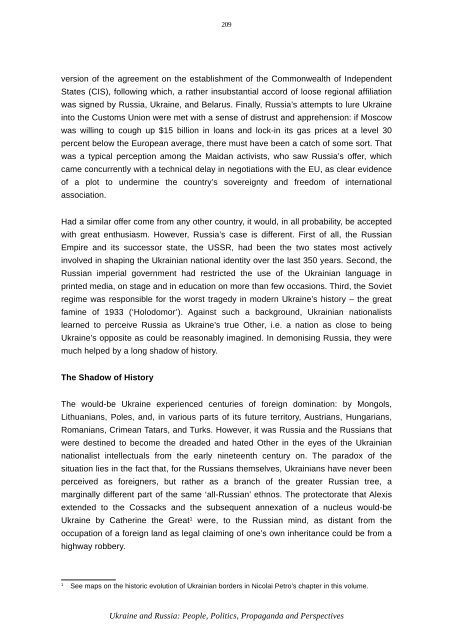Ukraine-and-Russia-E-IR
Ukraine-and-Russia-E-IR
Ukraine-and-Russia-E-IR
Create successful ePaper yourself
Turn your PDF publications into a flip-book with our unique Google optimized e-Paper software.
209<br />
version of the agreement on the establishment of the Commonwealth of Independent<br />
States (CIS), following which, a rather insubstantial accord of loose regional affiliation<br />
was signed by <strong>Russia</strong>, <strong>Ukraine</strong>, <strong>and</strong> Belarus. Finally, <strong>Russia</strong>’s attempts to lure <strong>Ukraine</strong><br />
into the Customs Union were met with a sense of distrust <strong>and</strong> apprehension: if Moscow<br />
was willing to cough up $15 billion in loans <strong>and</strong> lock-in its gas prices at a level 30<br />
percent below the European average, there must have been a catch of some sort. That<br />
was a typical perception among the Maidan activists, who saw <strong>Russia</strong>’s offer, which<br />
came concurrently with a technical delay in negotiations with the EU, as clear evidence<br />
of a plot to undermine the country’s sovereignty <strong>and</strong> freedom of international<br />
association.<br />
Had a similar offer come from any other country, it would, in all probability, be accepted<br />
with great enthusiasm. However, <strong>Russia</strong>’s case is different. First of all, the <strong>Russia</strong>n<br />
Empire <strong>and</strong> its successor state, the USSR, had been the two states most actively<br />
involved in shaping the Ukrainian national identity over the last 350 years. Second, the<br />
<strong>Russia</strong>n imperial government had restricted the use of the Ukrainian language in<br />
printed media, on stage <strong>and</strong> in education on more than few occasions. Third, the Soviet<br />
regime was responsible for the worst tragedy in modern <strong>Ukraine</strong>’s history – the great<br />
famine of 1933 (‘Holodomor’). Against such a background, Ukrainian nationalists<br />
learned to perceive <strong>Russia</strong> as <strong>Ukraine</strong>’s true Other, i.e. a nation as close to being<br />
<strong>Ukraine</strong>’s opposite as could be reasonably imagined. In demonising <strong>Russia</strong>, they were<br />
much helped by a long shadow of history.<br />
The Shadow of History<br />
The would-be <strong>Ukraine</strong> experienced centuries of foreign domination: by Mongols,<br />
Lithuanians, Poles, <strong>and</strong>, in various parts of its future territory, Austrians, Hungarians,<br />
Romanians, Crimean Tatars, <strong>and</strong> Turks. However, it was <strong>Russia</strong> <strong>and</strong> the <strong>Russia</strong>ns that<br />
were destined to become the dreaded <strong>and</strong> hated Other in the eyes of the Ukrainian<br />
nationalist intellectuals from the early nineteenth century on. The paradox of the<br />
situation lies in the fact that, for the <strong>Russia</strong>ns themselves, Ukrainians have never been<br />
perceived as foreigners, but rather as a branch of the greater <strong>Russia</strong>n tree, a<br />
marginally different part of the same ‘all-<strong>Russia</strong>n’ ethnos. The protectorate that Alexis<br />
extended to the Cossacks <strong>and</strong> the subsequent annexation of a nucleus would-be<br />
<strong>Ukraine</strong> by Catherine the Great 1 were, to the <strong>Russia</strong>n mind, as distant from the<br />
occupation of a foreign l<strong>and</strong> as legal claiming of one’s own inheritance could be from a<br />
highway robbery.<br />
1<br />
See maps on the historic evolution of Ukrainian borders in Nicolai Petro’s chapter in this volume.<br />
<strong>Ukraine</strong> <strong>and</strong> <strong>Russia</strong>: People, Politics, Propag<strong>and</strong>a <strong>and</strong> Perspectives


